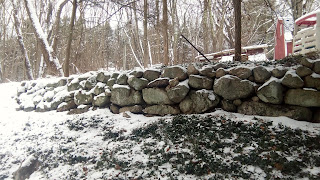Or: The Ograbme that Grabbed Me
Well now, you see: I think one of the distinguishing characteristics of Indigenous Stonework sometimes involves stacking stones to resemble snakes - Eastern Timber Rattlesnakes especially - and Great Snakes or Big Snakes or Horned Serpents, Great Serpents and all the other ways the Indigenous word for this sometimes protective Spirit Being has been translated into English, found to be so widespread in the western hemisphere in many artistic forms.
I try to see the courses of stones in stone wall-like constructions as possible snakes. I was once very much surprised when I applied this to a familiar wall at home, observing the pattern in a retaining wall that I had previously assumed was a Colonial wall, built by Euro-American Settlers sometime around 1700:
But what is that??
Since I have had more than one snapping turtle give me this exact sort of look,
I am reasonably sure that this is a Stone Snapping Turtle:
I stole (and cropped) this photo of a snapping turtle from
THANKS TO A 19TH CENTURY POLITICAL CARTOON, COMMON SNAPPING TURTLES ARE ALSO KNOWN AS "OGRABMES."
Urban~commonswiki via Wiki Commons // CC BY PD-US
"Drawn by Alexander Anderson, this piece skewers Thomas Jefferson’s signing of the unpopular Embargo Act. At the president’s command, we see a snapping turtle bite some poor merchant’s hind end. Agitated, the victim calls his attacker “ograbme”—“embargo” spelled backwards..."
I'm adding these photos to this post on January 10, 2019, my When I'm 64 Birthday:
I'm adding these photos to this post on January 10, 2019, my When I'm 64 Birthday:
Sometime between 1672 and 1740, European tools in the hands of the People Living at Nonnewaug Wigwams constructed this retaining wall and other stonework...
On 4/12/2022 I sadly add:



















No comments:
Post a Comment